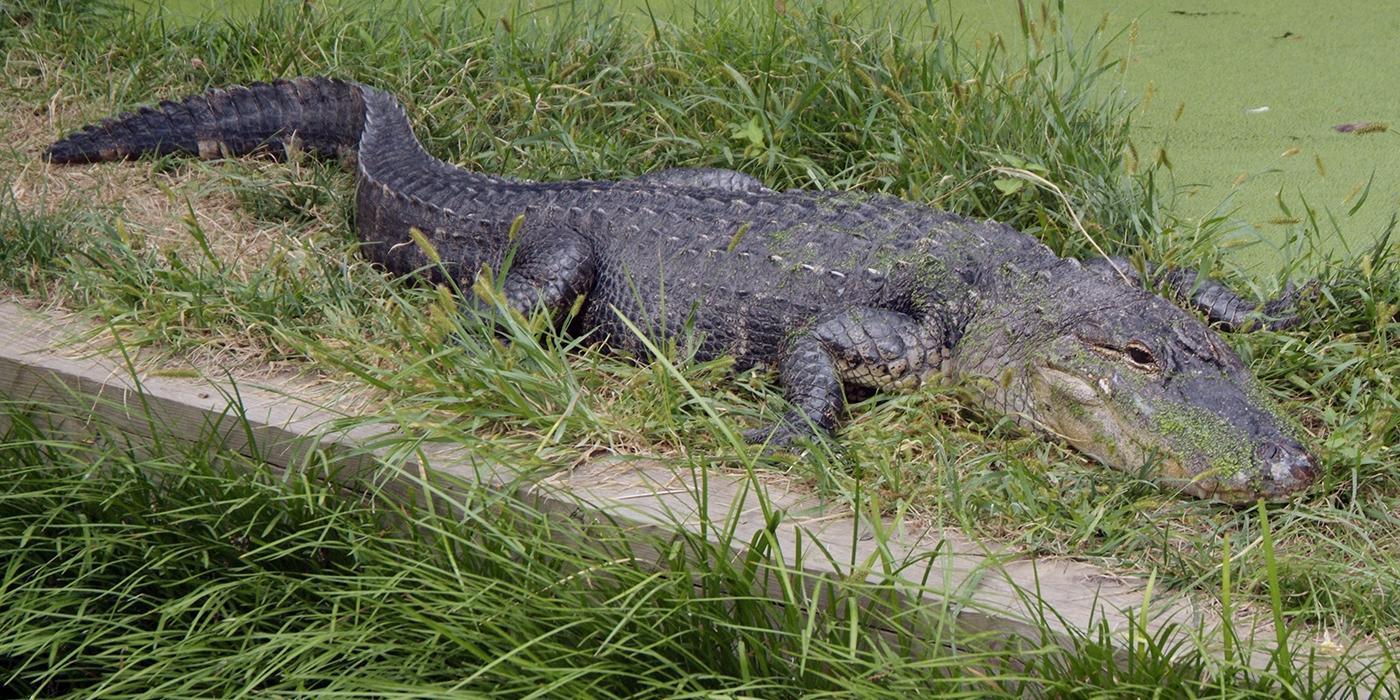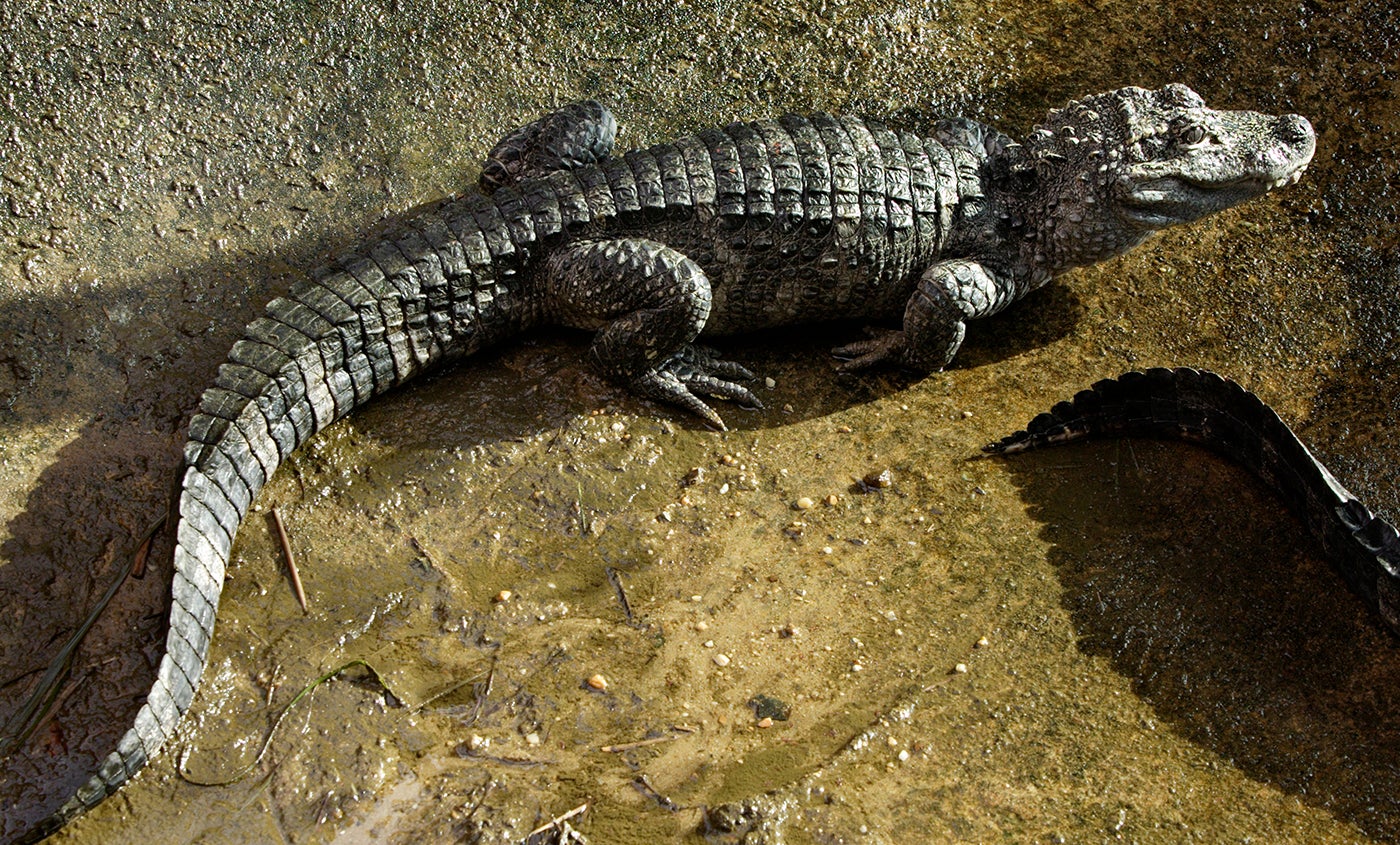How Long Can an Alligator Hold Its Breath? And Other Questions, Answered

Try not to get 'swamped' with these bite-sized facts about American alligators and their crocodilian cousins.
How long can an alligator hold its breath underwater?
A long time, especially if they’re hiding under the water’s surface and waiting for a prey animal to come by.
Alligators usually take a breath of air every 20 or 30 minutes. But some can hold their breath for up to 24 hours! Special adaptations give these amazing reptiles the ability to slow their heart rates to just 2 or 3 beats per minute, consuming the oxygen in their lungs at an incredibly slow rate.
What’s the difference between an alligator and a crocodile?
Alligators and crocodiles are separated by millions of years of evolutionary history—but you wouldn’t know it by looking at them!
Here’s how you can tell the two species apart:
- Check their snout — Alligators have short, wide snouts with rounded, U-shaped ends. Crocodiles have long, thin snouts with pointy, V-shaped ends.
- Look for visible teeth — Alligators have a bit of an overbite, which means their top jaw sticks out more from their lower jaw. When their mouths are closed, the teeth of their upper jaws poke out—and they’re mostly pointing downward. But a crocodile’s jaws are about the same size. When its mouth is closed, you see teeth pointing both upward and downward.
- Observe your surroundings—Alligators can only live in freshwater areas like ponds, swamps and lakes. Crocodiles have special salt glands that allow them to tolerate not only freshwater environments, but brackish and saltwater areas, like bays and coastal estuaries.
- Don’t get too close! Alligators are generally thought of as being calmer and less aggressive than crocodiles. However, both can be unpredictable, especially when hungry. Keep a very wide berth if you come across either species in the wild.
How many types of alligator are there?
While there are eight species in the Alligatoridae family, there are only two species that are usually referred to as alligators: the American alligator and the Chinese alligator.
Chinese alligators are smaller on average than their American cousins; full-grown adults usually reach about 4 to 5 feet long. This species—the only member of the Alligatoridae family to live outside of the Americas—can be found in the lower Yangtze River region in eastern China. They are also highly endangered; as few as 150 to 300 individuals remain in the wild today.

Do alligators have scales?
Yes. Alligators have soft, flexible scales on their undersides that feel almost like snakeskin. The upper parts of their bodies—including their backs, tails and necks—are covered in hard, armor-like scales called scutes. These tough scales protect their bodies from attacking animals (which, given their status as apex predators, usually means other alligators).
Where do American alligators live in the wild?
American alligators are common throughout the southeastern United States. Their range stretches as far north as North Carolina, and as far west as eastern Texas. They can also be found in Louisiana, Alabama, Oklahoma, Arkansas, Georgia, Florida, and South Carolina.
Alligators cannot tolerate below-freezing temperatures, so it’s unlikely to see them move beyond this range any time soon. But as the effects of climate change bring warmer temperatures to many parts of the country, researchers believe alligators could expand their range northward over the next century.
Their preferred habitats include swamps, ponds, marshes, slow-moving rivers and lakes. However, they can survive in many areas, provided there is clean freshwater and a ready supply of prey to eat. They can only tolerate saltwater for brief periods because they do not have functional salt glands.
Are alligators considered lizards?
Not quite. While alligators and lizards are both reptiles, scientists don’t think of them as being in the same family. Alligators, crocodiles, gharials and caimans are categorized as part of the taxonomical order Crocodilia. Meanwhile, lizards are part of the order Squamata, which also includes all living snakes.
How large do American alligators get?
When they first hatch from their eggs, baby alligators are just 6-8 inches (16-20 centimeters) long. However, with a healthy supply of food, they can add several inches of length and thickness to their bodies every year. Adults can grow to be more than 12 feet (3.6 meters) in length and weigh as much as 1,000 pounds (450 kilograms).
Do alligators make noises to communicate?
Yes! Adult males, called bulls, make a bellowing noise to attract females and to ward off other males during the breeding season. Alligator bellows have a deep, growling sound. They are also capable of making grunting, growling and hissing noises, especially when angry or provoked.
Did you know? Alligators can vocalize before they even hatch from their eggs! Baby alligators make high-pitched whimpering noises from inside the eggs that let their mother know they are ready to emerge. After hatching, they get their mother’s attention by making chirping noises that almost sound like peeping baby birds.
Do alligators care for their young?
Female alligators make pretty good moms. While many reptiles fend for themselves after hatching, alligators are one of the few species of reptiles that rely on their mother’s protection while young.
Female alligators create nests out of vegetation along the banks of marshes and ponds. They lay anywhere between 20 and 50 eggs at one time. After hatching, the mother will care for the babies by gently carrying them in her mouth or on her back to the water’s edge. There, they hunt for small animals like insects and snails under her watchful eye. Mother alligators will stay with their young for about a year.
However, this level of attentiveness and care only extends to the babies’ mothers. To nearby alligators who aren’t related? Well, food is food. Hatchlings are considered worthwhile prey animals for larger alligators seeking their next meal…if they can make it past the mother.
What do alligators eat?
Alligators are carnivores, relying on their strong jaws, thick necks and sharp teeth to catch prey. They are opportunistic predators and eat whatever is plentiful in their surroundings. Common prey animals include fish, snails and other invertebrates, birds, frogs, turtles and mammals that come to the water's edge.
Small alligators have high metabolisms and need to feed at least every few weeks to survive. Larger alligators can go without food for a year or more.
Do alligators hibernate?
Technically, no. But they do enter a state of dormancy when it gets cold.
Alligators and other reptiles are cold-blooded, meaning they rely on their surroundings and environment for warmth, rather than generating it from their bodies.
Alligators in some parts of their range dig a depression called a "gator hole" along a waterway and remain there in a state of dormancy during the cool winter months. In other areas, alligators dig tunnel-like hollows in the mud, which partially fill in with water. These tunnels can be as long as 65 feet (20 meters) and provide protection during the coldest months of the year.
Once the weather gets warm, they emerge from dormancy—and they’re usually pretty hungry!
Are alligators endangered?
American alligators lived in what is now the Southeastern U.S. for millions of years. By the mid-20th century, habitat loss and overhunting for the leather trade caused them to be eliminated from many parts of their range.
After legal protections were enacted by the United States government in 1967, American alligator populations started to recover dramatically. Now, scientists estimate there are over 4 million American alligators in the wild, in some cases returning to areas where they had been driven to extinction.
Other related species haven’t been so lucky. The Chinese alligator—the smaller cousin of the American alligator—is the most endangered member of the Alligatoridae family. Only about 200 of these animals are left in the wild. And the Cuban crocodile, which was once found throughout the swamps of Cuba, has seen its range reduced to just a few protected areas on the island.
Stop by the Reptile Discovery Center to see American alligators, Cuban crocodiles and Chinese alligators on your next visit to the Smithsonian’s National Zoo and Conservation Biology Institute in Washington, D.C.!